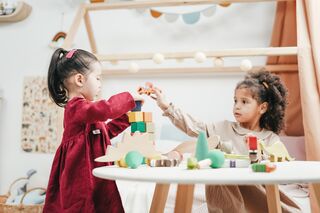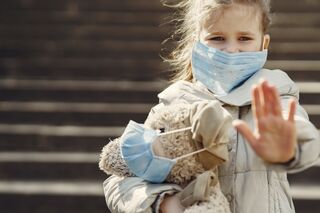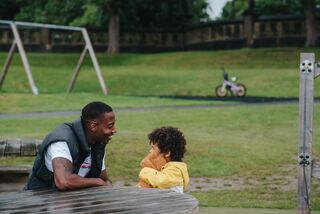Play
The Impact of Play Deprivation
Re-introducing play into our children's lives: Five tips for post-pandemic play
Posted April 25, 2021 Reviewed by Matt Huston
Key points
- Play is essential for a child's cognitive, social, emotional, and physical development. It helps them learn to process the world.
- When play is restricted, children may become anxious and their learning through mimicry may be impeded.
- Parents can help children return to play by incorporating it into family routines, thereby modeling its importance.
Co-authored by Laurel Bongiorno, Ph.D., and Kimberly Quinn, Ph.D.
Play is a key element of children’s learning and development. It is what they do naturally without adult input. Play provides opportunities for learning and development and also provides an opportunity to experience fun and joy. It provides an opportunity for a child to make sense of the adult world; play is part of a child’s resilience toolkit.

Children often play house or family because these are situations they know. But children also play handcuff games if they’ve seen a parent arrested. They hit the doll in the dollhouse if they have been struck. They shout at playmates if adults yell at them. They lovingly care for a doll if there’s a new baby at home. They play restaurant if this is an activity they know well. And, in a pandemic, we have seen them put masks on their stuffed animals, sit action figures far apart, and order pretend groceries on the computer. Children need the opportunity to play to understand the world around them.
Prior to the pandemic, activities such as organized sports, video game playing, television viewing, and parents’ safety concerns affected how much open-ended play children engaged in (Singer, Singer, D’Agostino, & DeLong, 2009). In his book The Ambiguity of Play, Brian Sutton-Smith proposed that the opposite of play is depression. That notion is something to consider as we think about the impact of the pandemic on play opportunities for children.
COVID-19 and play deprivation
For over a year, many parents kept their children indoors in fear of exposure to the coronavirus. Some children played in their backyards but were unable to engage socially with peers. Many playgrounds across the country were roped off, and children were not allowed access to them. Screens at home were made more available than usual.

These very abrupt changes, no doubt, brought anxiety to both children and their parents. In fact, COVID-anxiety has caused many children to shift into what can be called “survival brain,” which is governed by the limbic system and kicks into gear when there is trauma or big stress. It can shift a child out of a natural place of social and emotional growth to one of defend and protect. Children may express survival-induced anxiety by isolating, demanding more attention, or acting out.
Play is a key element of young children’s healthy development and learning in multiple domains: physical, cognitive, linguistic, social, and emotional (NAEYC, 2020). It is important for us all to be intentional about adding play back into children’s lives if it was deterred during the pandemic.
Some families, being home, actually found more time for children to play. Some children continued to attend child care programs and public schools. But many did not. Here are some tips for re-introducing play back into children’s lives as the country re-opens:
Tips for bringing play back
Go outside. Be very intentional in adding outdoor time back into children’s days. This can be at local parks, taking walks, going to a local school playground. Make sure there is time for joy and wonder and child-initiated play.

Break the screen cycle. Television and video games helped many children (and adults) pass the time at home. Consider what the family rules and routines pre-pandemic were, and think about how you will go forward as a family. You can model this by putting your own phone away, reducing your own screen time, and inviting your child to read a book, take a walk, or help make dinner.
Provide opportunities for open-ended play. Children love to run, jump, skip, kick a ball, or just lie in the grass. Indoors, provide children with art supplies, toys, and books that they can engage with independently. Give them space to engage their imaginations.
Add family playtime into your routine. Build a fort with a blanket. Play a board game. Relax and laugh together. Play is healing and supports resilience.

Add play into your own life. Adults may have been play-deprived, too. Model for your children and take your own walks. Laugh with friends. Play games. Cook your favorite food, or re-engage with a hobby you love. Your children are watching you as you re-engage post-pandemic. This suggestion is consistent with Albert Bandura’s well-known social learning theory (1977), which holds that children learn and encode what they observe from their “models,” making it more likely for them to mimic this behavior later on (McLeod, 2016).
Adding play back into all of our lives may reduce anxiety, depression, and stress and add to our abilities to re-engage in friendships and social activities, as well as to have fun again after a seemingly endless year. Play may bring all of us renewal and joy.
Dr. Laurel Bongiorno serves as the Dean of Education and Human Studies at Champlain College in Burlington, VT. Her scholarly work focuses on young children's learning through play, creativity, process art, and early childhood leadership.
References
McLeod (2016). Albert Bandura’s social learning theory. Simply Psychology. https://www.simplypsychology.org/bandura.html
NAEYC. (2020). Developmentally appropriate practice [position statement]. https://www.naeyc.org/resources/position-statements/dap/contents
Singer, D.G., Singer, J.L., D’Agostino, H. & DeLong, R. (2009). Children’s pastimes and play in sixteen nations: Is free-play declining? American Journal of Play. (1)3, 283-312.
Sutton-Smith, B. (2007). The Ambiguity of Play. Cambridge, Mass. Harvard University Press.
Yoffe, J. (2020). Supporting children with their anxieties during the COVID-19 pandemic. https://www.yoffetherapy.com/post/supporting-children-with-their-anxiet…




